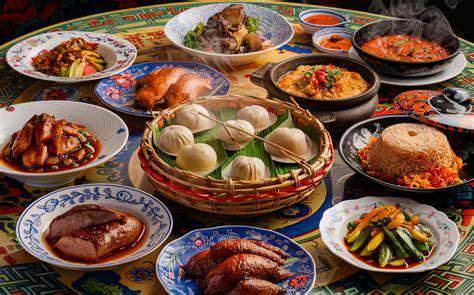Eating Habits in China: Regional Cuisines
Northern China: A Focus on Grains
Northern China's cuisine, deeply rooted in the agricultural landscape, emphasizes hearty dishes centered around grains like wheat and millet. The region's cooler climate lends itself to hearty stews, dumplings (jiaozi), and noodles. These staples, often seasoned with soy sauce, fermented black beans, and spices like cumin and coriander, reflect the practical and flavorful traditions of the north. The availability of wheat flour is central to northern Chinese cuisine, evident in the abundance of bread-like dishes and dumplings, which are often filled with meat or vegetables. This focus on grains showcases the region's agricultural history and culinary ingenuity.
Beyond the staples, the use of fermented ingredients like douchi (fermented soybeans) and kaoliang (fermented sorghum) adds unique and complex flavor profiles to many northern Chinese dishes. This emphasis on fermentation reflects a deep understanding of preserving food and enhancing its taste, a key aspect of northern Chinese culinary traditions.
Southern China: A Symphony of Fresh Flavors
Southern China, with its lush landscapes and diverse climate, boasts a vibrant culinary scene characterized by fresh, light flavors. The abundance of seafood, fruits, and vegetables is reflected in dishes that often feature stir-fries, soups, and rice. The use of ginger, garlic, and chilies adds a distinctive zest to many southern Chinese dishes, creating a spicy and aromatic experience. This region's cuisine is significantly diverse, reflecting the various microclimates and agricultural practices across the region.
The emphasis on fresh ingredients and light preparations is a hallmark of southern Chinese cuisine. This contrasts sharply with the heartier dishes of the north, showcasing the adaptability of Chinese culinary traditions to varying geographical conditions.
Sichuan: A Realm of Spicy Sensations
Sichuan cuisine is renowned for its fiery and numbing flavors, achieved through the masterful use of chili peppers, Sichuan peppercorns, and fermented black beans. The distinctive ma la (numbing and spicy) sensation is a defining characteristic of Sichuan dishes, which often feature richly flavored and aromatic ingredients. This unique approach to spice and flavor is a hallmark of Sichuan cuisine, which has earned a global reputation for its bold and complex taste profiles. The use of these ingredients in a wide range of dishes, from stir-fries to soups, adds a distinctive element to Sichuan culinary traditions.
Cantonese Cuisine: A Culinary Tradition of Refinement
Cantonese cuisine, originating in Guangdong province, is known for its refined presentation and delicate flavors. Dishes often incorporate fresh seafood, vegetables, and meat, prepared in a variety of techniques, including steaming, stir-frying, and braising. The emphasis on quality ingredients and meticulous preparation is a hallmark of Cantonese cooking, showcasing the region's culinary sophistication. Cantonese cuisine is highly regarded for its balance of flavors and textures, and its focus on fresh, high-quality ingredients.
Yunnan: A Fusion of Exotic Flavors
Yunnan province, situated on the southwest frontier of China, boasts a unique culinary landscape, blending diverse influences from neighboring Southeast Asian countries. The region's cuisine is a delightful fusion of flavors, incorporating exotic ingredients like mushrooms, wild greens, and fermented meats. Yunnan's cuisine is also rich in the use of herbs and spices, reflecting the region's unique biodiversity and cultural exchanges. This fusion of flavors and ingredients creates a truly distinctive culinary experience, highlighting the rich cultural heritage of the region.
Cantonese Cuisine: Elegant Simplicity and Culinary Mastery

A Culinary Journey Through Cantonese Elegance
Cantonese cuisine, renowned for its exquisite balance of flavors and meticulous preparation, offers a captivating journey through a symphony of tastes. From the delicate aromas of simmered soups to the satisfying crunch of stir-fried vegetables, each dish tells a story of culinary mastery. It's a cuisine that celebrates freshness and high-quality ingredients, resulting in dishes that are both aesthetically pleasing and incredibly flavorful.
This culinary tradition, deeply rooted in Cantonese culture, showcases a commitment to simplicity and sophistication. It's a testament to the artistry of preparing food, where every ingredient is carefully selected and each step of the cooking process is executed with precision. This approach, while seemingly simple, often involves intricate techniques passed down through generations, resulting in dishes that are both elegant and satisfying.
The Essence of Freshness and Flavor
A key characteristic of Cantonese cuisine is its focus on fresh, high-quality ingredients. This commitment to freshness is evident in the use of seasonal produce, succulent seafood, and tender meats. The cooking methods often highlight the natural flavors of these ingredients, rather than overpowering them with heavy sauces or spices.
The emphasis on natural flavors allows the true essence of each ingredient to shine through. This approach results in dishes that are light, yet incredibly flavorful, showcasing the natural goodness of the ingredients.
Beyond the Stir-Fry: A Diverse Culinary Palette
While stir-fries are a popular and recognizable part of Cantonese cuisine, the culinary landscape extends far beyond this staple. Cantonese cooking encompasses a wide array of dishes, from delicate dim sum to rich, flavorful soups and hearty noodle dishes. Each dish tells a unique story, reflecting the diverse influences and traditions that have shaped Cantonese culinary heritage.
The diverse range of dishes, from savory to sweet, showcases the creativity and adaptability of Cantonese cooks. This versatility makes Cantonese cuisine a true delight for any palate.
The Art of Presentation: A Visual Symphony
Cantonese cuisine isn't just about flavor; it's also about presentation. Dishes are often meticulously arranged, highlighting the beauty of the ingredients and the artistry of the preparation. This attention to detail elevates the dining experience, making it not only a feast for the palate but also for the eyes.
The visual appeal of Cantonese dishes adds another layer of enjoyment to the dining experience. The meticulous presentation of each dish enhances the overall appreciation of the culinary artistry.
Cantonese Cuisine: A Legacy of Culinary Tradition
From humble beginnings to global recognition, Cantonese cuisine has carved a unique niche in the culinary world. Its emphasis on fresh ingredients, precise preparation, and artful presentation has solidified its position as a beloved and respected culinary tradition. This legacy continues to inspire chefs and food enthusiasts alike, ensuring that the rich flavors and elegant traditions of Cantonese cuisine will continue to captivate for generations to come.
Its influence can be seen in cuisines around the world. This enduring appeal speaks to the enduring power of Cantonese culinary traditions.
A treasure hunt, whether it's a literal quest for buried gold or a metaphorical search for hidden value, begins with a careful visual inspection. This initial phase is crucial because it allows you to quickly identify potential areas of interest and eliminate those that are unlikely to hold significant value. Paying attention to the surroundings and any visible clues can significantly narrow down the search space and guide your investigation.
Shanghai Cuisine: A Fusion of Tradition and Modernity
A Rich Culinary Heritage
Shanghai cuisine boasts a rich and storied history, deeply rooted in the city's unique geographical location and its vibrant cultural exchange over centuries. From its humble beginnings as a trading hub, Shanghai's kitchens absorbed influences from neighboring regions, including Jiangsu, Zhejiang, and even further afield. This fusion of flavors and cooking techniques has resulted in a distinctive culinary identity that sets Shanghai cuisine apart from other regional styles within China.
The city's bustling markets and diverse populations have always been a melting pot of culinary ideas. This constant interplay of influences has shaped the evolution of Shanghai's cuisine, creating a dynamic and ever-evolving culinary landscape that continues to fascinate and inspire today.
Savory and Sweet: A Blend of Tastes
Shanghai dishes are renowned for their sophisticated balance of savory and sweet flavors. Often, dishes feature a harmonious interplay of rich sauces, delicate seasonings, and subtly sweet ingredients, creating a complex and nuanced taste profile. This unique flavor combination is a hallmark of Shanghai cuisine, distinguishing it from other regional styles that may lean more heavily toward one extreme or the other.
Beyond the savory and sweet, Shanghai cuisine incorporates a wide range of textures, from the crisp crunch of vegetables to the smooth richness of meats and seafood. This diverse textural experience further enhances the overall dining experience, adding another dimension to the already captivating flavors.
The Importance of Fresh Ingredients
Fresh, high-quality ingredients are paramount in Shanghai cuisine. The city's proximity to the sea and its vibrant agricultural markets ensure a steady supply of fresh seafood, vegetables, and meats. This dedication to using the freshest produce is reflected in the dishes, resulting in a vibrant and flavorful culinary experience.
The emphasis on freshness is not just about taste; it's also about preserving the natural essence and nutritional value of the ingredients. This commitment to quality ingredients is a key element of Shanghai's culinary identity and a testament to the city's commitment to providing its residents and visitors with exceptional food.
Modern Interpretations of Traditional Dishes
While deeply rooted in tradition, Shanghai cuisine is not stagnant. Modern chefs are constantly innovating and reinterpreting classic dishes, infusing them with contemporary techniques and ingredients. This fusion of tradition and modernity is a defining characteristic of Shanghai's culinary scene, reflecting the city's dynamic spirit and its willingness to embrace progress.
Beyond the Classics: A Diverse Culinary Landscape
Shanghai's culinary landscape extends far beyond the well-known classic dishes. From small street food stalls to upscale restaurants, the city offers a diverse range of culinary experiences, showcasing the versatility and adaptability of Shanghai cuisine. Exploring the city's diverse culinary offerings allows for a deeper appreciation of the various influences that have shaped this unique style.
The Role of Shanghai Cuisine in Chinese Dining
Shanghai cuisine plays a significant role in the broader context of Chinese dining. Its unique characteristics, blending tradition and modernity, provide a compelling example of how regional cuisines contribute to the rich tapestry of Chinese culinary history. This fusion of flavors and techniques has made Shanghai cuisine a significant force in the Chinese culinary landscape, influencing regional styles and inspiring new generations of chefs and foodies.
The city's status as a major cultural and economic center has further propelled Shanghai cuisine's importance in the global culinary scene, showcasing its distinctive character and drawing attention to its place within the broader spectrum of Chinese dining traditions.
Read more about Eating Habits in China: Regional Cuisines
Hot Recommendations
- Traditional Foods for Day of the Dead
- Food Etiquette in Italy: Pasta Rules!
- Best Family Friendly Restaurants with Play Areas in [City]
- Review: The Best [Specific Dessert] Place in [City]
- Top Ice Cream Parlors in [City]
- Traditional Foods for Halloween
- The History of the Potato in Ireland
- Best Vegan Pizza Joints in [City] [2025]
- Best Bakeries for Sourdough Bread in [City]
- Food Culture in Argentina: Asado and Wine

![Review: [Specific Type of Food, e.g., ramen] in [City] My Favorite Spot](/static/images/28/2025-05/MoreThanJustaMeal3ATheAmbianceandService.jpg)
![Top Places for Hot Dogs in [City]](/static/images/28/2025-05/HiddenGemsandLocalFavorites3ADiscoveringtheUnexpected.jpg)








